Blog
The Feeling of Colour – Clerkenwell 2024

From visiting Clerkenwell Design week 2024, our designers picked up lots of inspiration from colour to design and texture. YesColours hosted a talk ‘The Feeling of Colour’ as part of Conversations at Clerkenwell. A discussion about how artists and designers use colour within their work was brought to us by Emma Bestley – YesColours, Jenny Wingfield – Studio Flock, Lois O’ Hara – Artist and Simon Astridge – Architect.
YesColours was founded by Emma Bestley and John Stubbs during the first lockdown, to bring vibrant colours to the home. Taking a different approach to sustainability with fully recyclable packaging and local UK suppliers, their carbon footprint is kept to a minimum.
Emma Bestley starts the talk explaining her approach to colour living with synesthesia. This involves associating words and numbers with colour. Many artists, such as Van Gogh are also said to have lived with sound – colour synesthesia. Hearing certain sounds allowed him to see colours and patterns, shown within his work through vibrant and expressive movements. From this, Emma raises the point that colour is not just seen but also felt, a strong message shared throughout this discussion.
How do you approach the process of selecting colours for your work?
Lois O’ Hara, a bold artist from Brighton transforms public spaces with colour and design. Lois adapts various outdoor spaces using vibrant colours and therefore, a lot of her inspiration is drawn from nature. Using her own photography and knowledge of what works in these areas, she is able to colour pick a palette to create brighter areas for the community.

Simon Astridge also had a similar approach of choosing colours from natural beauty within our surroundings. In particular, he is inspired by sunsets and the colours merging into one another. The country of where Simon’s buildings are situated can also play a big part in his design decisions. For example, the colours from certain flowers in the surrounding areas or the culture and the clothing. This again reminds us of the reoccurring message of bringing the outdoors in.
Do you follow trends when creating a scheme?
The consensus was no, the panel did not rely solely on trends but instead treat each project uniquely. Lois suggests that we may incorporate things that we have seen on Pinterest or Instagram etc however, we should use these trends with guidance and not distinctly follow.
Jenny explains about a design she displays in her house, ‘Brazil’ by Josef Frank. These bright acid colours have reoccurred through design since 1945 and are still successful within a scheme. However, if we solely rely on trends for colour and use what is suggested as being current, the project would not be timeless as:
“Taste will become boring with time”. Jenny Wingfield.
Simon further adds to the conversation by explaining that if we were to give everyone the same colour red, there would be many variations of the shade. Colour is personal to each individual and this cannot be translated from one to another. Similarly, with projects, each one should be treated individually as it is its own space therefore, requiring its own colour palette. If trends were followed continuously, we would end up in a world surrounded by very similar interior spaces. These would then require to be refreshed every year, or even every season!
Design and Science
Emma starts this topic with her synesthesia and how having an unhealthy obsession with colour can affect her day. For example, Tuesdays are associated with a jarring cyan blue, creating a sense of uncertainty about the day ahead. The impact colour was having on Emma’s wellbeing encouraged her to research further into neuroscience and collaborations between art and science.
Furthermore, Simon Astridge explains his experience at a Moving Boundaries Conference in Mexico which involved 60 architects and 60 scientists. They visited Luis Barragan’s pink and purple houses, Casa Gilardi. Cleverly, each wall was painted a slightly different shade of the chosen colour depending on when the sunlight would hit the wall. This would change the perception of the space throughout the day. It is places like Casa Gilardi where colour is used in bold and exciting ways, creating a reaction and various emotions.

Further to this research, YesColours investigated the impact that green can have on us as a society. The colour green is used in many areas across design and is proven to be a calming colour. For example, green light is said to relieve chronic pain, reducing their dependence on painkillers and offering a feeling of relaxation. This colour is also quite often seen in care homes and will be the last colour they see. This suggests an element of peace and tranquillity. However, colour theory and how we can use certain colours in these spaces is arguably not spoken about enough. The panel were of the same opinion that colour theory was not brought to their attention throughout their studies but something they have researched individually. The collaborations with design and science are proving to be finding new ways we can use colour to have a positive impact on our wellbeing.
Future of Colour
Lois starts this topic with the view that people should gain more confidence using colour. Colour shouldn’t be feared as it can be very powerful when entering a room or public space, having a memorable impact on others.
However, Jenny also makes an interesting point that everything is moving more towards digital rather than physical print. Sadly, colours are being chosen based on engagement and likes rather than on real emotion. This is based on pixels on the screen instead of our physical surroundings. Viewing these colours through the screen also makes them appear more saturated and vivid compared to when in natural light. However, this may not be considered a negative if we want people to be bolder with their choices on colour.
On the other hand, artists and designers also enjoy immersive and tactile experiences. Google’s exhibition at Milan Design Week, ‘Making Sense of Colour’ shows how colours are perceived through the senses. This multi-sensory space brings the world of synesthesia to others as neon lights sync with music and vibrations. This is an example of new ways that are being developed to experience colour for conditions such as synesthesia or if one has a sensory loss.
This discussion gave us a further insight into design and science with new ideas that we can bring into carpet design. Having not heard of synesthesia before, it was an interesting insight into Emma’s world when using colour.
Nature and our surrounding areas as their main inspiration was a common theme within the talk. Greens and subtler versions of pink including Pantone’s Colour of the Year ‘Peach Fuzz’ are becoming more popular which were also evident when walking round Clerkenwell design week.

Using these softer undertones within our carpet designs also means that designers can then incorporate bolder shades of fabrics within the interior space. These colours create a feeling of ease and tranquillity, a common theme throughout Clerkenwell.
Keep an eye out for our new Express Collection ‘Elements’, where we have incorporated a similar message of bringing the outdoors in!
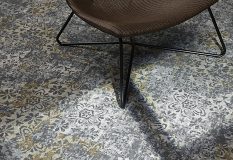 Stock Collections
Stock Collections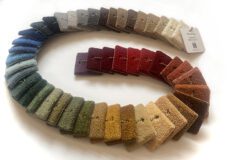 Axminster Archive
Axminster Archive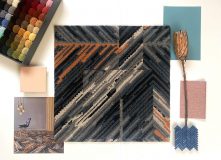 Express Collection
Express Collection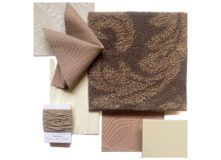 Bespoke Design Service
Bespoke Design Service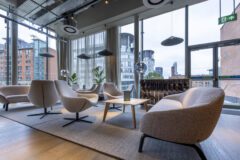 Area Rugs
Area Rugs Heritage
Heritage Local Supply
Local Supply News
News Meet our Team
Meet our Team